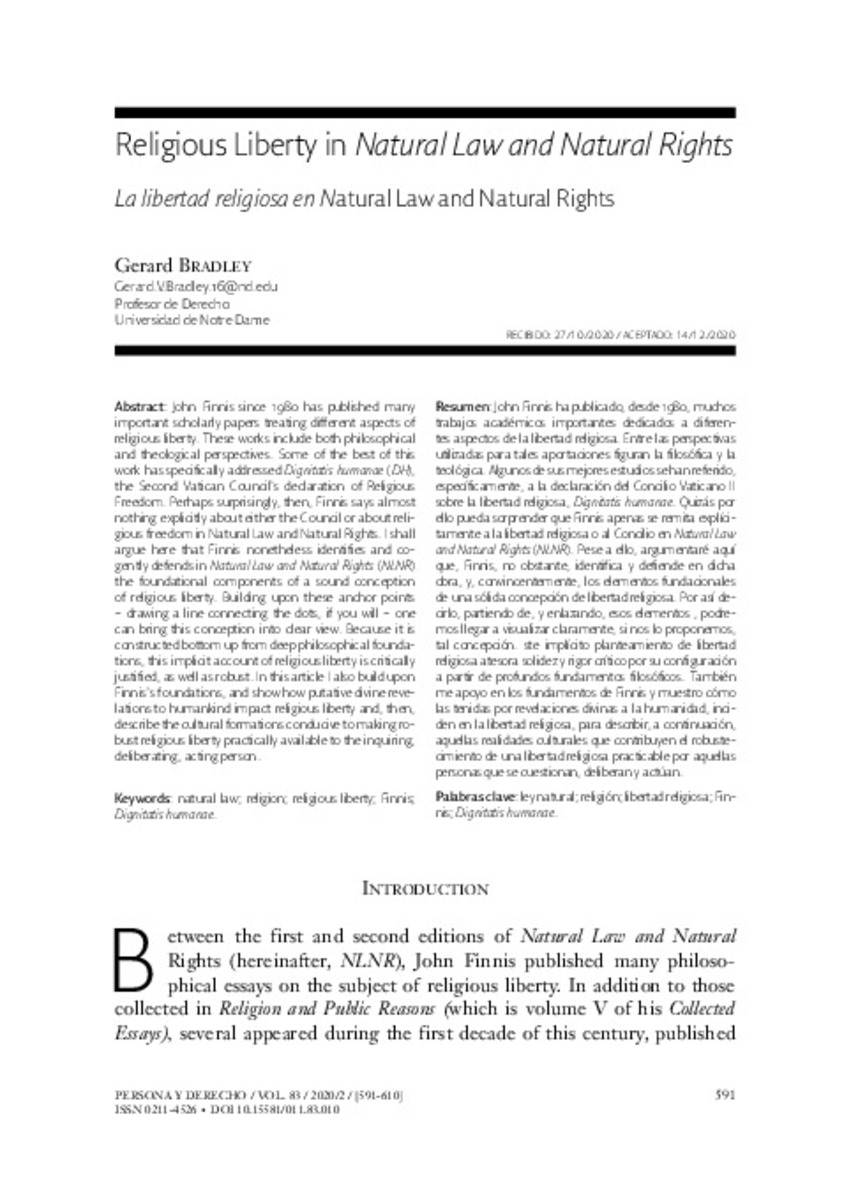Full metadata record
| DC Field | Value | Language |
|---|---|---|
| dc.creator | Bradley, G. (Gerard) | - |
| dc.date.accessioned | 2020-12-28 | - |
| dc.date.accessioned | 2021-08-25T09:55:45Z | - |
| dc.date.available | 2021-08-25T09:55:45Z | - |
| dc.date.issued | 2020 | - |
| dc.identifier.citation | Bradley, G. (Gerard). "Religious Liberty in «Natural Law and Natural Rights»". Revista Persona y Derecho. 83, 2020, 591 - 610 | es |
| dc.identifier.issn | 0211-4526 | - |
| dc.identifier.uri | https://hdl.handle.net/10171/61662 | - |
| dc.description.abstract | John Finnis since 1980 has published many important scholarly papers treating different aspects of religious liberty. These works include both philosophical and theological perspectives. Some of the best of this work has specifically addressed Dignitatis humane, the Second Vatican Council’s declaration of Religious Freedom. Perhaps surprisingly, then, Finnis says almost nothing explicitly about either the Council or about religious freedom in Natural Law and Natural Rights. I shall argue here that Finnis nonetheless identifies and cogently defends in <em>Natural Law and Natural Rights </em>(<em>NLNR</em>) the foundational components of a sound conception of religious liberty. Building upon these anchor points – drawing a line connecting the dots, if you will – one can bring this conception into clear view. Because it is constructed bottom up from deep philosophical foundations, this implicit account of religious liberty is critically justified, as well as robust. In this article I also build upon Finnis’s foundations, and show how putative divine revelations to humankind impact religious liberty and, then, describe the cultural formations conducive to making robust religious liberty practically available to the inquiring, deliberating, acting person. | en_US |
| dc.description.abstract | John Finnis ha publicado, desde 1980, muchos trabajos académicos importantes dedicados a diferentes aspectos de la libertad religiosa. Entre las perspectivas utilizadas para tales aportaciones figuran la filosófica y la teológica. Algunos de sus mejores estudios se han referido, específicamente, a la declaración del Concilio Vaticano II sobre la libertad religiosa, <em>Dignitatis humanae</em>. Quizás, por ello, pueda sorprender que Finnis apenas mencione la libertad religiosa o dicho Concilio, en <em>Natural Law and Natural Rights </em>(<em>NLNR</em>). Pese a ello, argumentaré aquí que, Finnis, no obstante, identifica y defiende en la citada obra, y de forma convincente, los elementos fundacionales de una sólida concepción de libertad religiosa. Por así decirlo, siguiendo esos puntos de apoyo puede componerse un relato que permita visualizar dicha concepción. En la medida en que dicho relato parte de profundos fundamentos filosóficos que justifican el tránsito de lo más elemental a lo superior, ésta implícita concepción de libertad religiosa presenta rigor crítico y consistencia. También me apoyo en los fundamentos de Finnis y muestro cómo las tenidas por revelaciones divinas a la humanidad, inciden en la libertad religiosa Describo, a continuación, aquellas realidades culturales que promueven el robustecimiento de una libertad religiosa sólida, practicable por aquellas personas que se cuestionan, deliberan y actúan. | es_ES |
| dc.language.iso | eng | - |
| dc.publisher | Servicio de Publicaciones de la Universidad de Navarra | es_ES |
| dc.rights | info:eu-repo/semantics/openAccess | es_ES |
| dc.subject | ley natural | - |
| dc.subject | religión | - |
| dc.subject | libertad religiosa | - |
| dc.subject | Finnis | - |
| dc.subject | Dignitatis humanae | - |
| dc.title | Religious Liberty in «Natural Law and Natural Rights» | en_US |
| dc.title.alternative | Religious Liberty in «Natural Law and Natural Rights» | es_ES |
| dc.type | info:eu-repo/semantics/article | es_ES |
| dc.identifier.doi | 10.15581/011.83.010 | - |
| dadun.citation.endingPage | 610 | - |
| dadun.citation.publicationName | Revista Persona y Derecho | - |
| dadun.citation.startingPage | 591 | - |
| dadun.citation.volume | 83 | - |
Files in This Item:
Statistics and impact
Items in Dadun are protected by copyright, with all rights reserved, unless otherwise indicated.






